Hello fellow lovers of all things green, Mile-a-Minute Weed is running rampant, and now is the time to address it before the berries ripen. While at the eye doctor the other day, Pat at the front desk described her overwhelming mile-a-minute dilemma, reminding me of a client long ago who turned her dilemma into a haven for butterflies filled with native deer-resistant butterfly plants.
Mile-a-Minute Weed Smothers Its Host
Mile-a-Minute weed (Persicaria perfoliate) is a light green vine with almost perfect triangular leaves that grows as much as six inches a day and twenty-five feet a season. It’s also known as “Devil’s tail tear thumb” as it resembles the native Halberdleaf tearthumb (Polygonum arifolium) and Arrowleaf tearthumb (P. sagittatum). But the pea-sized blue fruits and the almost perfect triangular leaves are distinctive of Mile-a-minute.
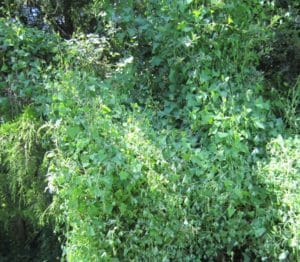
Mile-a-Minute weed (Persicaria perfoliate) smothering host trees.
It hangs like thick draperies on trees and shrubs, which can kill them quickly as it shades its host from photosynthesis. Folks compare it to the Kudzu dilemma that suffocates trees in warmer climates. Each plant produces thousands of green berries in mid-July.
It’s when the berries ripen to a reflective blue hue that birds and other critters flock, which is how it spreads rapidly by way of their excrements. Mile-a-Minute came from transport from eastern Asia in the 1930s. It arrived in our neck of the woods in nursery plants delivered to York, Pennsylvania.
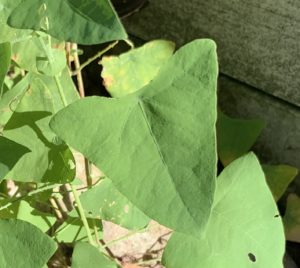
The almost perfect triangular leaves stand out.
Mile-a-Minute Remedies
Continually mowing, weeding out, or allowing your goats and sheep to graze is the most effective way to remove it. They are shallow-rooted and easy to pull, so weed them out sooner rather than later. Otherwise, it’s hard to get to the origin of the plant, as with Sarah’s case in Hope, NJ. However, I suggested she keep yanking with thick gloves to protect her from their prickly parts until she gets to the roots. The good news is it’s an annual. And, if you don’t allow the berries to ripen, you can stay ahead of the dilemma.
There is a biological control using a weevil (Rhinocominus latipes), native to China, Japan, Korea, and the Russian Far East, that feeds on the plants. Studied for several years before being released to ensure they would not harm native plants, they feed on the stems of mile-a-minute, killing the foliage above it, thereby reducing the number of seeds that form.
One of my clients released the weevil, but it hasn’t had a dramatic impact on his huge population. So, a combination of a manual and biological approach is probably the best strategy if you are inundated. If it hasn’t gone to seed, it’s fine to compost it. Otherwise, a brown bag in the trash is best to quarantine the berries from taking over our world.
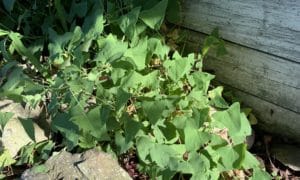 Native deer-resistant butterfly plants.
Native deer-resistant butterfly plants.
Sarah cleared out her mile-a-minute weedy dilemma and proudly sent photos. She asked if there was a list of native deer-resistant butterfly plants she could consider to invite butterflies to her garden and yard. Yes indeed!
Native plants are often easier to grow, and more importantly, insects and animals rely on them. For example, an oak tree can support over 500 species of moths and butterflies, amongst other insects. In contrast, a Bradford Pear (a common ornamental non-native) supports fewer than 100. The more insects, the more bird food available.
The Native Plant Society of New Jersey publishes Host Plants, which provide a habitat for butterfly larvae (caterpillars) that they feed on and indicate which species they attract. They also publish a list of Native Nectar Plants. These plants are native to Pennsylvania and many other areas, but check with your local native plant society. I’ve cross-referenced the Butterfly Plants with Deer Resistant Native Plants and came up with the following beauties.
Deer-resistant tree hosts include Birches, Eastern Red Cedar, American Holly, Oaks, Pines, Paw Paw, and Redbud. Once leaves rise above browsing level, other native host trees like Sassafras, Tulip Trees, Hickories, and Walnuts are deer-resistant too.
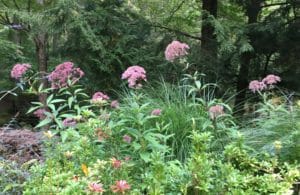
Joe-Pye Weed (Eupatorium)
Shrub hosts that deer don’t crave include Dogwoods, Meadowsweets, Arrowood Viburnum, Black haw Viburnum, Chokeberries, NJ Tea, and Spicebush. The latter two are nectar plants as well. Host native grasses and sedges include Little Bluestem, Panic Grasses (Panicum), and Sedges (Carex).
“To have butterflies, we need to make butterflies.”
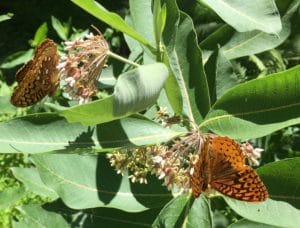
Common Milkweed (Asclepias syriaca)
There are many deer-resistant native nectar plants such as Beebalm (Monarda), Blazing Stars (Liatris), Coneflowers, Goldenrod, Hyssops, Ironweed, Tickseed, Phlox, and Sneezeweed. My very favorite is in its late-summer glory now—Joe Pye Weed with its mop-like burst of pinkish mauve fluff rising four to seven feet high.
Perhaps you are wondering why Butterfly Bush is not on the list. Not only is it not native, but caterpillars don’t feed on the plant.
Douglas Tallamy, the author of the must-read Bringing Nature Home, writes, “To have butterflies, we need to make butterflies.” He cites milkweeds (Asclepias) as the must-have host and nectar plants. By planting an assortment such as Butterfly Weed, Common Milkweed, and Swamp Milkweed, you’ll attract many species of butterflies from June through September.
So, dig in and help make more butterflies. Sorry, Deer, we’ll stick with deer-resistant plants.
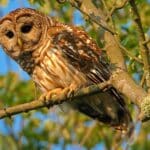
Barred Owl – photo by Blaine Rothauser
Garden Dilemmas? AskMaryStone@gmail.com and your favorite Podcast App.
There’s more to the story in the Garden Dilemmas Podcast, including bits about a Barred Owl you’ll enjoy:
For more information about the weevil to remediate Mile-a-Minute Weed:
https://www.nj.gov/agriculture/divisions/pi/pdf/mileaminute.pdf
https://biocontrol.entomology.cornell.edu/weedfeed/Rhinoncomimus.php


